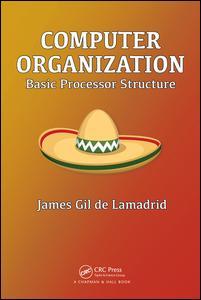Computer Organization Basic Processor Structure
Auteur : Gil de Lamadrid James

Computer Organization: Basic Processor Structure is a class-tested textbook, based on the author?s decades of teaching the topic to undergraduate and beginning graduate students. The main questions the book tries to answer are: how is a processor structured, and how does the processor function, in a general-purpose computer?
The book begins with a discussion of the interaction between hardware and software, and takes the reader through the process of getting a program to run. It starts with creating the software, compiling and assembling the software, loading it into memory, and running it. It then briefly explains how executing instructions results in operations in digit circuitry. The book next presents the mathematical basics required in the rest of the book, particularly, Boolean algebra, and the binary number system.
The basics of digital circuitry are discussed next, including the basics of combinatorial circuits and sequential circuits. The bus communication architecture, used in many computer systems, is also explored, along with a brief discussion on interfacing with peripheral devices. The first part of the book finishes with an overview of the RTL level of circuitry, along with a detailed discussion of machine language.
The second half of the book covers how to design a processor, and a relatively simple register-implicit machine is designed. ALSU design and computer arithmetic are discussed next, and the final two chapters discuss micro-controlled processors and a few advanced topics.
1. Overview 2. Number, and Logic Systems 3. Digital Circuitry 4. Devices And The Bus 5. The Register Transfer Language Level 6. Common Computer Architectures 7. Hardwired Cpu Design 8. Computer Arithmetic 9. Micro-Programmed Cpu Design 10. A Few Last Topics
James Gil de Lamadrid has a PhD in Computer Science from the University of Minnesota. He has been a professor in Computer Science at Bowie State University since 2004.
Date de parution : 03-2018
15.6x23.4 cm
Date de parution : 03-2018
15.6x23.4 cm
Thèmes de Computer Organization :
Mots-clés :
Tea Pot; source; High Order Bit; operand; Low Order Bit; assembly; Source Operand; language; Load Instruction; sequential; Ripple Carry Adder; circuits; Sequential Circuits; truth; Address Bus; table; Stack Machine; address; Truth Table; bus; Combinational Circuit; James Gil de Lamadrid; Memory Unit; Conditional Branches; Assembly Language; Accumulator Machine; Register Machine; Transition Table; Clock Cycle; Machine Language; Peripheral Devices; Cache Unit; Data Word; Cache Entry; Register File; Mealy Machine



